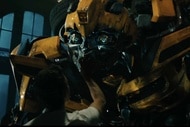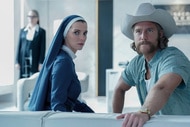Create a free profile to get unlimited access to exclusive videos, sweepstakes, and more!
HBO's Watchmen bet everything on the tragic Black Wall Street massacre opening

When Nicole Kassell got the call from frequent collaborator Damon Lindelof about his new TV series, he had just finished the script for the pilot of Watchmen, his HBO continuation of the seminal comic book of the same name. HBO hadn’t ordered the high-profile show straight to series, instead making its pickup contingent on that first episode, so Lindelof needed a trusted hand to helm the pilot.
Kassell had to pitch for the project, but once she clinched the gig, she got right to work on the show’s opening sequence — and then stayed focused on the first eight minutes of the first episode for most of her prep time. The show takes place in the modern world, updating the 1980s setting of the original Alan Moore comic, but Linedeloff wrote a stunning, cataclysmic opening sequence set in the 1921 massacre on Tulsa’s Black Wall Street, setting up both the show’s overarching themes and a few important plot points.
Black Wall Street was the nickname given to the booming Greenwood district in early 20th century Tulsa, where black-owned businesses thrived and the tight-knit African American community flourished. In May 1921, after days of hostilities, around 1,500 racist whites ransacked the neighborhood for two blood-soaked days, setting it ablaze in a riot that ultimately burned down 1000 homes and killed up to 300 black residents.
In the Watchmen opening, a young child sitting in a silent movie theater gets caught up in the violence of the riots and whisked into a getaway car by his parents as bullets whiz by and explosions rock the bloodied streets. Black citizens are dragged from cars by their feet and buildings are set ablaze — glass crashing and screams providing the soundtrack.
Lindelof first learned about the massacre, also known as the Tulsa Race Riot, when he read “The Case for Reparations,” the culture-shifting essay written by the author Ta-Nehisi Coates for The Atlantic in 2014. Further exploration of the Black Wall Street tragedy led the TV auteur to finally agree to adapt the comic — he had been approached about it twice before — and make reparations an inciting element of his story.
“He felt if he's going to do homage to the source,” Kassell explains to SYFY WIRE, “what was the equivalent issue or crisis or point of anxiety in our country that was nuclear war in the '80s? It was race.”
In this Watchmen, President Robert Redford instituted reparations for victims of the Tulsa riot and their direct descendants, so it was crucial to depict the sheer brutality of the slaughter, as painful as it is to watch.
“It was so important that even the very first thing I did in prep after coming on was go to Tulsa and to actually see the location of Greenwood,” Kassell says. “It took up the majority of our prep for the pilot because of the scale.”
Kassell dove into her research, reading a book Lindelof gave her about the Black Wall Street massacre, The Burning by Tim Madigan. She distributed copies of the text to her assistant director and everyone who worked on the team, and they used it for both inspiration and direct reference.
“From that,” she says, “we drew the narrative beats that you see the boy witness.”
The whole sequence needed to be meticulously plotted out, because they shot on location instead of in a studio. Kassell’s team found a modern stretch in a Macon, Georgia town that had the necessary layout and infrastructure, with roads that could stand-in for the drag of Main Street and Greenwood Avenue that would then allow them to turn into the garage where the hurried, fateful goodbye takes place.
After rehearsing in a dressed-up backlot, the streets of Macon were affixed with period-appropriate detail, with more intended to be added via post-production and visual effects. It was all painstakingly done, in an incredibly tight window.
“In terms of filming time, we had a day and a half on the street, and half a day in the garage,” Kassell explains. “Production design-wise, it was definitely a huge undertaking, and for hair, makeup, costume, it was massive. It was a movie of its own.”



























